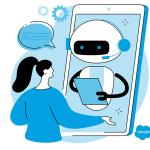With inputs from Chandan D.M., Lead Solution Engineer
Technology is at the core of R&D in medicine and healthcare. But the delivery of healthcare services is still burdened by legacy systems. In the wake of the COVID-19 pandemic, the Indian government increased its healthcare budget by 137% in 2021. While this is a good start, there is a need for massive technological transformation among healthcare providers to improve citizen access to affordable healthcare.
According to Forbes, big data, AI-driven automation in healthcare, and remote medicine are among the top healthcare industry trends in 2021. Such technologies can help streamline healthcare solutions by shifting the approach of care delivery from curative to preventative. And this shift will be enabled by access to comprehensive digital patient databases for all relevant stakeholders. A smart patient management system (PMS) can help healthcare providers combine electronic medical records (EMR) with intelligent analytics, and build a comprehensive Patient 360 view.
As today’s digital-first patients’ demands evolve, technology can empower all members of a patient’s health journey and help healthcare organisations to deliver more personalised, value-based care.
Start by creating a single view of the patient
Typically, a patient’s medical details are spread over many disconnected systems, making it difficult for healthcare providers to deliver accurate, contextualised services. To create a 360-degree view of each patient, providers must do away with close-ended local systems and move their patient databases onto the cloud. This can help them deliver data-backed, smarter care decision-making by:
- Consolidating patient data from across sources – EMRs, insights from caregivers, wearable devices, etc. – onto a cloud-based platform
- Equipping patients, providers, caregivers, and partners with access to critical information whenever needed
- Enabling healthcare teams to collaborate seamlessly from a single point of engagement that offers access to all the patients’ data
Once this ‘single source of patient truth’ is in place, technology can transform healthcare systems for the next normal. Here’s how:
1. Hyperpersonalise patient care with automation in healthcare
Every patient has unique needs. Having access to their complete medical histories on a single platform enables healthcare providers to deliver personalised medical services at scale. They can combine patient data with predictive intelligence to:
- Segment patient profiles based on factors such as age, medical conditions, health risks, etc.
- Recognise patterns among patient groups to predict illness trends and possible outbreaks
- Proactively provide preventative care based on each patient’s medical history and susceptibilities
- Contact patients on their preferred communication channels
2. Unify the healthcare ecosystem for a consistent and reliable service delivery
While governments and providers are continuously striving to improve the delivery of healthcare services, the patient’s journey continues to be complicated. According to the National Health Policy 2017, healthcare providers in India can use the technological infrastructure provided by the government to create and share EMRs with patients and access those issued by other providers with patient consent. With access to complete medical histories, healthcare providers can ensure patients get the best care faster.
Further, by empowering care team members, patients, and partners with the right tools and technologies, providers can:
- Streamline healthcare solutions by automatically assigning healthcare professionals to the right tasks
- Look into the availability of resources and staff to increase operational efficiencies
- Increase collaboration between hospitals, diagnostic centres, caregivers, supply chain managers, insurance providers, etc.
- Identify and address bottlenecks in the system using interactive reports and dashboards.
3. Enhance the patient’s experience through self-service and real-time access to healthcare
Due to the ongoing pandemic, patients avoid physical visits unless absolutely necessary. They seek on-demand healthcare services and quick issue resolution. The Indian telemedicine market is expected to reach $5.5 billion by 2025, helping reduce the rural-urban healthcare gap. Providers can use technology to empower patients and increase satisfaction by:
- Deploying chatbots, self-service portals, and video assistance tools to provide instant advice and support.
- Empowering service agents to deliver proactive assistance with recommended next best steps and knowledge resources.
- Allowing patients to take control of their journey towards better health by providing self-service platforms and online communities.
- Automatically transferring data from wearables and medical devices into the PMS to provide real-time patient health status.
- Sharing alerts for upcoming appointments, test results, health progress, etc.
How smart patient management systems translate into a connected patient journey
Smart Patient Management Systems empower healthcare providers to offer connected and hyperpersonalised patient journeys. A patient gets complete 24/7 access to healthcare facilities through their preferred channels – mobile apps, WhatsApp, phone calls, websites, or more. So, they are able to access care without delay.
A healthcare ecosystem consolidating data on a single platform offers a single source of patient truth that allows patients to: book tests, book a hospital room, order medicines, fix appointments, access their up-to-date medical history, raise an insurance claim, call for an ambulance, or make payments for any medical services using a single app or portal. No matter which hospital or healthcare provider a patient chooses, the experience and navigation on healthcare apps or portals can be standardised (with the help of APIs). This means patients will experience seamless transitions and connected experiences across service providers and channels of interaction.
An increased awareness of healthcare and lifestyle diseases, rise in income, and increased access to healthcare insurance, is all leading to an Indian healthcare market that is predicted to touch $372 billion by 2022. To keep up with healthcare trends and improve healthcare administration, public and private players must look to immediately automate and streamline healthcare processes in smart, cost-effective ways.
How Salesforce can help
Salesforce Health Cloud is an industry-specific CRM that can help provider organisations attract, serve, and engage patients seamlessly across their health journeys.
Click here to see how you can transform your healthcare organisation and deliver the experiences your patients deserve.

























